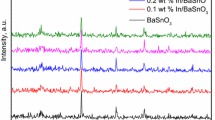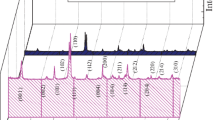Abstract
Barium cerate BaCeO3, with the perovskite-like and 4f electronic structure of its conduction band, is a material that found applications in photocatalytic hydrogen production from water splitting and solid oxide fuel cells. In fine-tuning of the material, one needs to overcome the hurdle of fast recombination of photogenerated electron–hole pairs. This usually is achieved via metal and other atoms do**. In this paper, we report our attempts to increase the efficiency of the water-splitting reaction when using BaCeO3 by do** it with V, Ag, Au, and Pt. Pure BaCeO3 nanoneedles were synthesized employing a sol–gel method. The nanoneedles were then doped with the afore-mentioned elements. Characterization of the material was carried out via XRD, UV–Vis, TEM, PL, photocurrent intensity, and N2-adsorption measurements. Photocatalytic water splitting was set up under conditions that simulate the natural sunlight with the utilization of glycerol as a scavenger. While pure BaCeO3 does not show appreciable activity towards water splitting, Pt–BaCeO3 produced the best results compared with the other three elements used as dopants. The rate of H2 production using BaCeO3, V–BaCeO3, Ag–BaCeO3, Au–BaCeO3, and Pt–BaCeO3 was 28, 500, 900, 1800, and 2400 μmol g−1, respectively. The superior performance of Pt-doped and Au-doped BaCeO3 can be explained by the narrow bandgap (Pt: 2.16 eV, Au: 2.36 eV), high surface area (Pt: 36.0 m2/g, Au: 38.0 m2/g), and the compatible 4f electronic structure of BaCeO3 and Pt and Au.

Hourly evolved H2 concentrations against reaction time for the five photocatalysts.
Highlights
-
BaCeO3 nanoneedles and V, Ag, Au, and Pt-doped BaCeO3 nanoneedles have been prepared via sol–gel process.
-
Heterogeneous the photocatalytic process was employed for hydrogen production.
-
Pt-doped and Au-doped BaCeO3 nanoneedles have superior performance for hydrogen production.
-
Rate of hydrogen evolved of Pt-doped BaCeO3 nanoneedles are higher than 85.7 for BaCeO3 nanoneedles.
-
Reusability test demonstrated the photostability of Pt-doped BaCeO3 nanoneedles after five cycles.








Similar content being viewed by others
References
Lee DW, Won JH, Shim KB (2003) Low temperature synthesis of BaCeO3 nanopowders by the citrate process. Mater Lett 57:3346–3351
Houa J, Cao S, Wu Y, Liang F, Ye L, Linc Z, Sun L (2016) Perovskite-based nanocubes with simultaneously improved visible-light absorption and charge separation enabling efficient photocatalytic CO2 reduction. Nano Energy 30:59–68
YeonDo J, Im Y, Kwak B, Park SM, Kang M (2016) Preparation of basalt fiber@perovskite PbTiO3 core–shell composites and their effects on CH4 production from CO2 photoreduction. Ceram Int 42:5942–5951
Schober T, Krug F, Schilling W (1997) Criteria for the application of high temperature proton conductors in SOFCs. Solid State Ion 97:369–373
Munch W, Kreuer KD, Seifert G, Maier J (2000) Proton diffusion in perovskites: comparison between BaCeO3, BaZrO3, SrTiO3, and CaTiO3 using quantum molecular dynamics. Solid State Ion 136– 137:183–189
Wen Y, Yang S, Gu S, Ye X, Wen Z (2017) Fabrication and characterization of a double-layer electrolyte membrane for BaCeO3-based reversible solid oxide cells (RSOCs). Solid State Ion 308:167–172
Zhang Z, Chen L, Li Q, Song T, Su J, Cai B, He H (2018) High performance In, Ta and Y-doped BaCeO3 electrolyte membrane for proton-conducting solid oxide fuel cells. Solid State Ion 323:25–31
Yuan Y, Zheng J, Zhang X, Li Z, Yu T, Ye J, Zou Z (2008) BaCeO3 as a novel photocatalyst with 4f electronic configuration for water splitting. Solid State Ion 178:1711–1713
Zhang Q, Ding J, He M (2017) First principles study on structural, lattice dynamical and thermal properties of BaCeO3. J Phys Chem Solids 108:76–81
Wang J, Huang C, Chen X, Zhang H, Li Z, Zou Z (2015) Photocatalytic CO2 reduction of BaCeO3 with 4f configuration electrons. Appl Surf Sci 358:463–467
Samgin AL (2000) Do** effects on protonic conduction in SrCeO3 and BaCeO3 based perovskites. Inorg Mater 36:816–819
Mumtaz S, Ahmad MA, Raza R, Arshad MS, Ahmed B, Ashiq MN, Abbas G (2017) Nano grained Sr and Zr co-doped BaCeO3 electrolytes for intermediate temperature solid oxide fuel cells. Ceram Int 43:14354–14360
Künstler K, Lang HJ, Maiwald A, Tomand G (1998) Synthesis, structure and electrochemical properties of In-doped BaCeO3. Solid State Ion 107:221–229
Medvedev DA, Gorbova EV, Demin AK, Tsiakaras P (2014) Conductivity of Gd-doped BaCeO3 protonic conductor in Н2–Н2О–О2 atmospheres. Int J Hydrogen Energy 39:21574–21552
Petit CTG, Tao S (2013) Structure and conductivity of praseodymium and yttrium co-doped barium cerates. Solid State Sci 17:115–121
Presto S, Viviani M (2016) Effect of CuO on microstructure and conductivity of Y-doped BaCeO3. Solid State Ion 295:111–116
Acknowledgements
This article was funded by the Deanship of Scientific Research (DSR) at King Abdulaziz University, Jeddah. The authors therefore acknowledge with thanks DSR for technical and financial support.
Author information
Authors and Affiliations
Corresponding author
Ethics declarations
Conflict of interest
The authors declare that they have no conflict of interest.
Additional information
Publisher’s note: Springer Nature remains neutral with regard to jurisdictional claims in published maps and institutional affiliations.
Rights and permissions
About this article
Cite this article
Kadi, M.W., Mohamed, R.M. Synthesis of BaCeO3 nanoneedles and the effect of V, Ag, Au, Pt do** on the visible light hydrogen evolution in the photocatalytic water splitting reaction. J Sol-Gel Sci Technol 91, 138–145 (2019). https://doi.org/10.1007/s10971-019-05018-y
Received:
Accepted:
Published:
Issue Date:
DOI: https://doi.org/10.1007/s10971-019-05018-y




